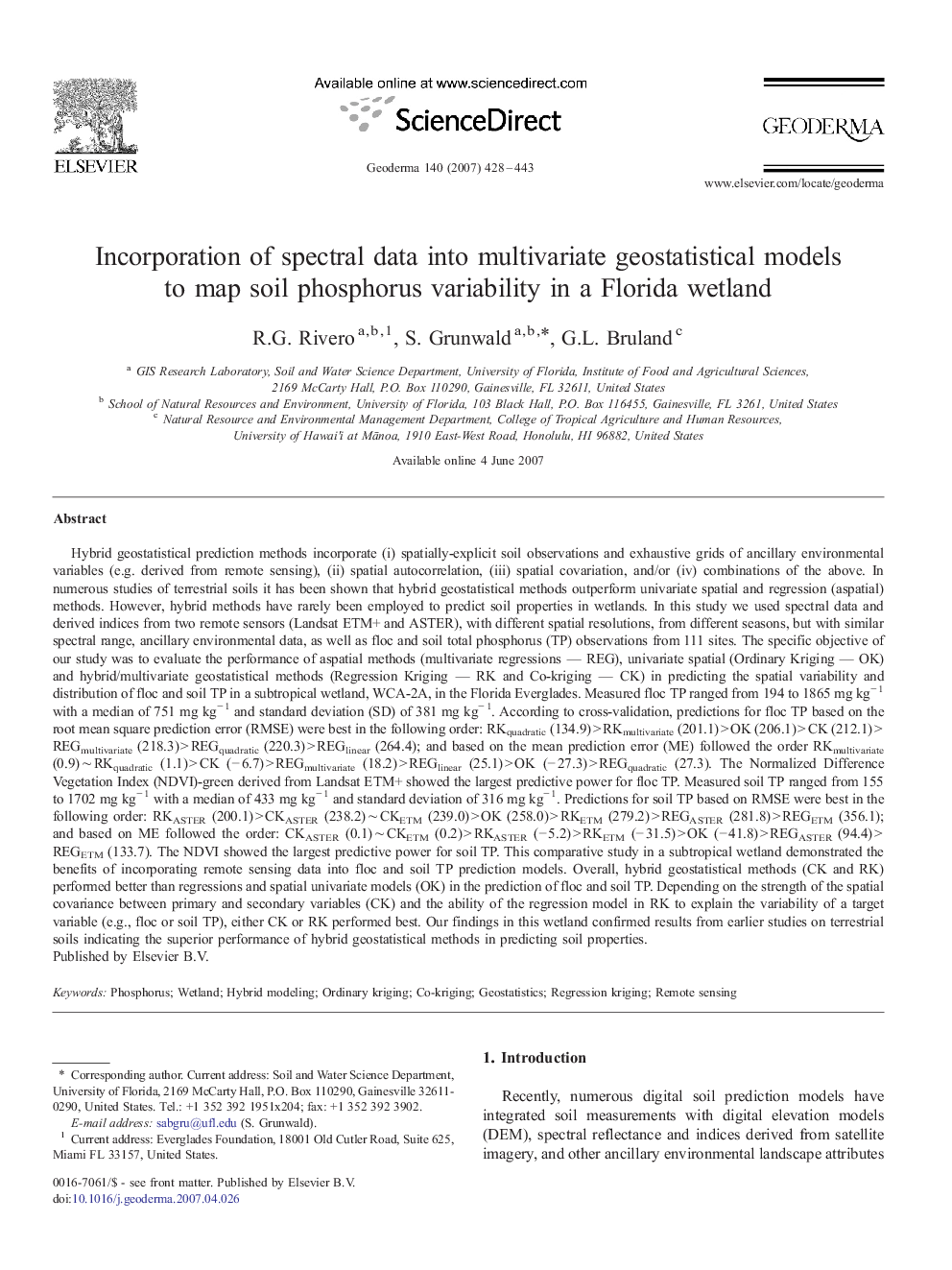| کد مقاله | کد نشریه | سال انتشار | مقاله انگلیسی | نسخه تمام متن |
|---|---|---|---|---|
| 4575109 | 1629552 | 2007 | 16 صفحه PDF | دانلود رایگان |

Hybrid geostatistical prediction methods incorporate (i) spatially-explicit soil observations and exhaustive grids of ancillary environmental variables (e.g. derived from remote sensing), (ii) spatial autocorrelation, (iii) spatial covariation, and/or (iv) combinations of the above. In numerous studies of terrestrial soils it has been shown that hybrid geostatistical methods outperform univariate spatial and regression (aspatial) methods. However, hybrid methods have rarely been employed to predict soil properties in wetlands. In this study we used spectral data and derived indices from two remote sensors (Landsat ETM+ and ASTER), with different spatial resolutions, from different seasons, but with similar spectral range, ancillary environmental data, as well as floc and soil total phosphorus (TP) observations from 111 sites. The specific objective of our study was to evaluate the performance of aspatial methods (multivariate regressions — REG), univariate spatial (Ordinary Kriging — OK) and hybrid/multivariate geostatistical methods (Regression Kriging — RK and Co-kriging — CK) in predicting the spatial variability and distribution of floc and soil TP in a subtropical wetland, WCA-2A, in the Florida Everglades. Measured floc TP ranged from 194 to 1865 mg kg− 1 with a median of 751 mg kg− 1 and standard deviation (SD) of 381 mg kg− 1. According to cross-validation, predictions for floc TP based on the root mean square prediction error (RMSE) were best in the following order: RKquadratic (134.9) > RKmultivariate (201.1) > OK (206.1) > CK (212.1) > REGmultivariate (218.3) > REGquadratic (220.3) > REGlinear (264.4); and based on the mean prediction error (ME) followed the order RKmultivariate (0.9) ∼ RKquadratic (1.1) > CK (− 6.7) > REGmultivariate (18.2) > REGlinear (25.1) > OK (− 27.3) > REGquadratic (27.3). The Normalized Difference Vegetation Index (NDVI)-green derived from Landsat ETM+ showed the largest predictive power for floc TP. Measured soil TP ranged from 155 to 1702 mg kg− 1 with a median of 433 mg kg− 1 and standard deviation of 316 mg kg− 1. Predictions for soil TP based on RMSE were best in the following order: RKASTER (200.1) > CKASTER (238.2) ∼ CKETM (239.0) > OK (258.0) > RKETM (279.2) > REGASTER (281.8) > REGETM (356.1); and based on ME followed the order: CKASTER (0.1) ∼ CKETM (0.2) > RKASTER (− 5.2) > RKETM (− 31.5) > OK (− 41.8) > REGASTER (94.4) > REGETM (133.7). The NDVI showed the largest predictive power for soil TP. This comparative study in a subtropical wetland demonstrated the benefits of incorporating remote sensing data into floc and soil TP prediction models. Overall, hybrid geostatistical methods (CK and RK) performed better than regressions and spatial univariate models (OK) in the prediction of floc and soil TP. Depending on the strength of the spatial covariance between primary and secondary variables (CK) and the ability of the regression model in RK to explain the variability of a target variable (e.g., floc or soil TP), either CK or RK performed best. Our findings in this wetland confirmed results from earlier studies on terrestrial soils indicating the superior performance of hybrid geostatistical methods in predicting soil properties.
Journal: Geoderma - Volume 140, Issue 4, 15 August 2007, Pages 428–443